End-Burning Rocket Motors
Attempts to simulate a Jetex or Rapier-type motor
I have long thought that recrystallized sugar propellant might work
well as a substitute for guanadine nitrate in Jetex-type motors.
But I have never seen a Jetex work, and do not have much in the
way of specifications on them. So I will do the best I can to
make a long-burning small motor, and hope for convergence at some point.
Today I built four end-burning motors using recrystallized KN/sucrose,
catalyzed with 1 percent red iron oxide (RIO) to speed the burn rate.
The RIO also makes it burn more smoothly at low Kn levels.
The tubes are 3/4ths inch inside diameter, and a little over 1 inch
outside diameter. They are made in the same manner as my model rocket motor tubes, except that the strip of posterboard is 26 inches long.
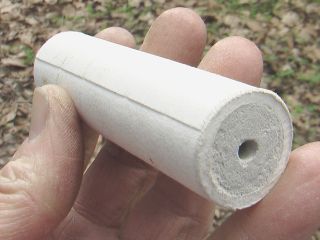
I start by cutting a section of tubing the desired length, then ramming
two teaspoons of Bentonite clay in one end. The clay is rammed as
a solid plug, the nozzle throat is drilled later.
Propellant is softened by heating to 200 degrees or a little hotter,
until it has the texture of putty or modeling clay. The inside of
the tube is painted with 5-minute epoxy, and the tube rammed full of
warm propellant. The head end is covered with a thick layer
of epoxy, both for strength, and to reduce burn-through.
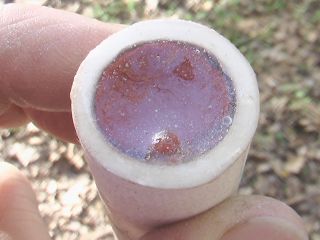
Then I take the motor to the drill press and drill the nozzle throat,
going through the clay until I reach propellant. By entering the
propellant a short distance, a small core is created.
A bare bridge wire ignitor is bent over and inserted in the nozzle
until it bottoms-out on the propellant. The first of these
worked. The second one didn't, so I started putting a pinch of
meal powder in the nozzle for insurance. All three of these
worked the first time.
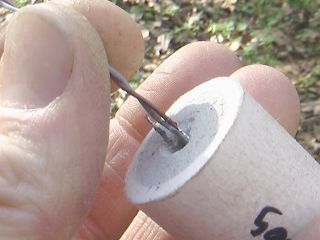
The motors were fired in a static test stand, so that I could get some data. This stand is using the 44lb load cell from Aerocon Systems
It has proven remarkably versatile, but may not be accurate in
this very low pressure range. I cranked the gain up on my little INA125 amplifier as high as it would go, and it seemed to work. I got a bump on the graph at least.
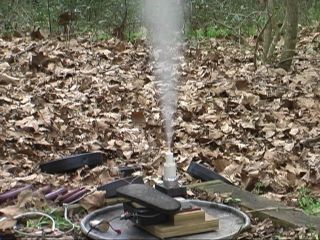
Four tests were done:
Test 1: 2/26/06B1
Test 2: 2/26/06B2
Test 3: 2/26/06B3
Test 4: 2/26/06B4
Click on each for a video of that test. Each file is about 1 megabyte, .wmv file, 8 seconds or so of video.
The first one, B1, popped its nozzle. The nozzle throat diameter
was 1/8th inch, so I enlarged the next one to .175 inch and it worked
fine.
I have analyzed only one of these so far, and that is #3. Click Here for the Excel spreadsheet file.
Quick summary:
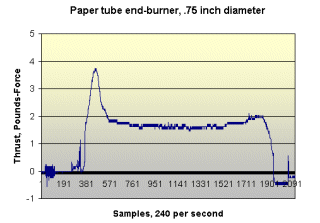
Grain diameter: 0.75 inch
Nozzle throat diameter: 0.175 inch
Propellant grain length: 2.922 inches
Propellant grain mass: 36.6 grams
Kn ratio: 18
Nozzle throat diameter after firing: 0.166 inch
Burn time: 6.72 seconds
Average thrust: 1.79 lbf
Peak thrust: 3.73 lbf
Peak pressure, derived from thrust: 155 psi.
Total thrust: 52.24 Newton-seconds
ISP: 146 (!)
That ISP is impossible, and must be an error in the testing somewhere.
I will do the analysis of the other motors tomorrow and see what
gives. It could be that the test stand is just not accurate at
this low level.
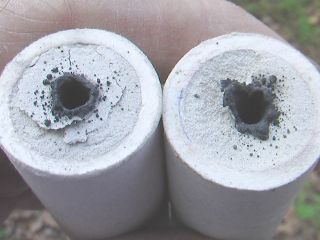
That the nozzles suffered "negative erosion" is not too surprising.
A major product of combustion of this propellant is potassium
carbonate, produced as a fine mist of molten droplets which quickly
solidify when they hit the air. That's the white smoke! But
this stuff gurgles a bit inside the motor, and often lines the nozzle
on a low-pressure motor. Good news is that it limits nozzle
throat erosion, bad news is that it spits and sputters a bit during the
burn.
One can analyze the O/F ratio of the propellant by this slag... if it
is black, then the propellant is fuel-rich. If it is grey, it is
oxidizer-rich. If one burns propellant and gets both black puffy
stuff and grey puddles, it is poorly mixed. This batch was made
with extra Karo syrup, which would have made it fuel-rich.
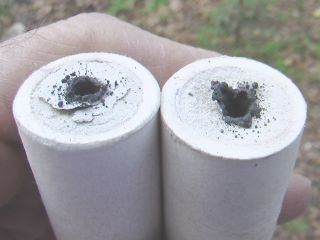
Well that was fun. And I now know that these motors have enough
thrust to propel themselves upward. So even if they do not work well
for model aircraft, they might be good as long-burn sustainers in
a two stage model.
Jimmy Yawn
2/26/06
jyawn@sfcc.net
Recrystallized Rocketry






